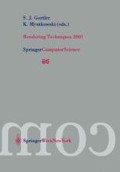Abstract
We present a new data structure for encoding the appearance of a geometric model as seen from a viewing region (view cell). This representation can be used in interactive or real-time visualization applications to replace a complex model by an impostor, maintaining high quality rendering while cutting down rendering time. Our approach relies on an object-space sampled representation similar to a point cloud or a layered depth image, but introduces two fundamental additions to previous techniques. First, the sampling rate is controlled to provide sufficient density across all possible viewing conditions from the specified view cell. Second, a correct, antialiased representation of the plenoptic function is computed using Monte Carlo integration. Our system therefore achieves high quality rendering using a simple representation with bounded complexity. We demonstrate the method for an application in urban visualization.
Access this chapter
Tax calculation will be finalised at checkout
Purchases are for personal use only
Preview
Unable to display preview. Download preview PDF.
References
Daniel Aliaga, Jon Cohen, Andrew Wilson. Eric Baker. Hansong Zhang, Carl Erikson, Keny Hoff, Tom Hudson, Wolfgang Stürzlinger, Rui Bastos, Mary Whitton, Fred Brooks, and Dinesh Manoclia. MMR: An interactive massive model rendering system using geometric and image-based acceleration. In 1999 Symposium on interactive 3D Graphics, pages 199–206,1999.
Daniel G. Aliaga and Anselmo Lastra. Automatic image placement to provide a guaranteed frame rate. Computer Graphics, 33:307–316, 1999.
Jin-Xiang Chai, Xin Tong, Shing-Chow Chan. and Heung-Yeung Shum. Plenoptic sampling. In Siggrapph 2000, Computer Graphics Proceedings. pages 307–318, 2000.
Chun-Fa Chang, Gary Bishop. and Anselmo Lastra. LDI tree: A hierarchical representation for image-based rendering. In Siggraph 1999, Computer Graphics Proceedings, pages 291–298. ACM Siggraph. 1999.
NVIDIA Corporation. Nv_vertex_program extension specification. 2000. available at http://www.nvidia.com/Marketing/Developer/DevRel.nsf/Pro-grammingResourcesFrame.
NVIDIA Corporation. Using texture compression in opengl, 2000. available at http://www.nvidia.comlMarketing/Developer/DevRel.nsflWhitepapersFrame.
Lucia Darsa. Bruno Costa Silva. and Amitabh Varshney. Navigating static environments using image-space simplification and morphing. In 1997 Symposium on Interactive 3D Graphics. pages 25–34.1997. ISBN 0-89791-884-3.
Xavier Decoret, Franrçois Sillion, Gernot Schaufler. and Julie Dorsey. Multi-layered impostors for accelerated rendering. Computer Graphics Forum, 18(3):61–73, 1999. ISSN 1067-7055.
Steven J. Gortler, Radek Grzeszczuk, Richard Szeliski, and Michael F. Cohen. The lumigraph. In SIGGRAPH 96 Conference Proceedings, pages 43–54, 1996. held in New Orleans, Louisiana, 04–09 August 1996.
J. P. Grossman and William J. Dally. Point sample rendering. In Rendering Techniques’ 98, pages 181–192. 1998.
Marc Levoy and Pat Hanrahan. Light field rendering. In SIGGRAPH 96 Conference Proceedings, pages 31–42,1996. held in New Orleans, Louisiana, 04–09 August 1996.
Marc Levoy and Turner Whitted. The use of points as a display primitive. Technical Report TR 85-022, University of Carolina at Chapel Hill, 1985.
Dani Lischinski and Ari Rappoport. Image-based rendering for non-diffuse synthetic scenes. In Rendering Techniques’ 98, pages 301–314,1998.
P. Maciel and P. Shirley. Visual navigation of large environments using textured clusters. SIGGRAPH Symposium on Interactive 3-D Graphics, pages 95–102, 1995.
William R. Mark, Leonard McMillan, and Gary Bishop. Post-rendering 3D warping. In 1997 Symposium on Interactive 3D Graphics, pages 7–16,1997. ISBN 0-89791-884-3.
Nelson Max. Hierarchical rendering of trees from precomputed multi-layer Z-buffers. In Eurographics Rendering Workshop 1996, pages 165–174, 1996. ISBN 3-211-82883-4.
Leonard McMillan and Gary Bishop. P1enoptic modeling: An image-based rendering system. In SIGGRAPH 95 Conference Proceedings, pages 39–46, 1995. held in Los Angeles, California, 06–11 August 1995.
Alexandre Meyer and Fabrice Neyret. Interactive volumetric textures. In Rendering Techniques’ 98, pages 157–168, 1998.
Gavin Miller, Steven Rubin, and Dulce Ponceleon. Lazy decompression of surface light fields for precomputed global illumination. In Rendering Techniques’ 98, pages 281–292, 1998.
Hanspeter Pfister, Matthias Zwicker, Jeroen van Baar, and Markus Gross. Surfels: Surface elements as rendering primitives. In Siggraph 2000, Computer Graphics Proceedings, pages 335–342,2000.
Szymon Rusinkiewicz and Marc Levoy. QSplat: A multiresolution point rendering system for large meshes. In Siggraph 2000, Computer Graphics Proceedings, pages 343–352, 2000.
G. Schaufler and W. Stürzlinger. A three-dimensional image cache for virtual reality. In Proceedings of EUROGRAPHICS’ 96, 1996.
Gernot Schaufler. Per-object image warping with layered impostors. In Rendering Techniques’ 98, pages 145–156, 1998.
Jonathan Shade, Dani Lischinski, David Salesin, Tony DeRose, and John Snyder. Hierarchical image caching for accelerated walkthroughs of complex environments. In SIGGRAPH 96 Conference Proceedings, pages 75–82, 1996. held in New Orleans, Louisiana, 04–09 August 1996.
Jonathan W. Shade, Steven J. Gortler, Li-wei He, and Richard Szeliski. Layered depth images. In SIGGRAPH 98 Conference Proceedings, pages 231–242, 1998. ISBN 0-89791-999-8.
Franrçois Sillion, G. Drettakis. and B. Bodelet. Efficient impostor manipulationfor real-time visualization of urban scenery. Computer Graphics Forum. 16(3):207–218, 1997. Proceedings of Eurographics’ 97. ISSN 1067-7055.
Peter Wonka, Michael Wimmer, and Dieter Schmalstieg. Visibility preprocessing with occluder fusion for urban walkthroughs. In Rendering Techniques 2000. pages 71–82, 2000.
Daniel N. Wood, Daniel I. Azuma, Ken Aldinger, Brian Curless, Tom Duchamp, David H. Salesin, and Werner Stuetzle. Surface light fields for 3D photography. In Siggraph 2000, Computer Graphics Proceedings, pages 287–296,2000.
Author information
Authors and Affiliations
Editor information
Editors and Affiliations
Rights and permissions
Copyright information
© 2001 Springer-Verlag Wien
About this paper
Cite this paper
Wimmer, M., Wonka, P., Sillion, F. (2001). Point-Based Impostors for Real-Time Visualization. In: Gortler, S.J., Myszkowski, K. (eds) Rendering Techniques 2001. EGSR 2001. Eurographics. Springer, Vienna. https://doi.org/10.1007/978-3-7091-6242-2_15
Download citation
DOI: https://doi.org/10.1007/978-3-7091-6242-2_15
Published:
Publisher Name: Springer, Vienna
Print ISBN: 978-3-211-83709-2
Online ISBN: 978-3-7091-6242-2
eBook Packages: Springer Book Archive

